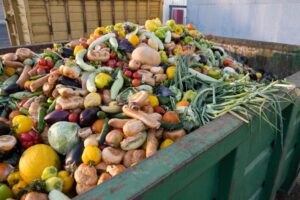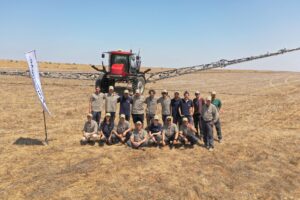- The United States generated 91 million tons of “surplus food” in 2021, representing 38% of the country’s entire food supply, according to updated figures from food waste non-profit ReFED.
- Despite 80% of this surplus food being edible, less than 2% of it was donated.
- Consumer households generate half of all surplus food, followed by consumer-facing businesses.
- Funding and measurement are currently the biggest barriers to wider adoption of food waste solutions.
- ReFED executives are hopeful “we’ve reached peak waste” in 2023.
The $444bn surplus food problem
ReFED defines “surplus food” as “food that goes unsold or uneaten.”
Households in the US generate about 50% of this surplus food, while consumer-facing businesses like restaurants and grocery stores generate another 20%.
Collectively, surplus food accounts for nearly 6% of annual greenhouse gas emissions in the US, or the equivalent of driving 83 million passenger vehicles for a full year, says ReFED.
The new data comes from ReFED’s Insights Engine, an online hub that tracks food waste in the US. The Insights Engine combines public and proprietary datasets from more than 50 sources along with subject matter expertise from food system professionals in ReFED’s Expert Network.
Estimates are now updated through 2021, according to ReFED.
Beyond emissions, producing food that becomes surplus uses 22% of freshwater and 16% of cropland in the US.
ReFED estimates the value of unsold or uneaten food at $444 billion in 2021. The amount is equivalent to “149 billion meals’ worth of food that could have gone to the 10% of Americans who struggle with food insecurity.”

Barriers to food waste mitigation
The two biggest barriers to more widespread food waste solutions are “not enough measurement and not enough funding,” ReFED communications director Jeffrey Costantino tells AFN.
“We pull together our estimates from dozens of different data sets, but there’s still so much that’s not being measured, so businesses don’t know where to focus their efforts. It’s hard for food businesses to accurately measure their loss and waste and then to serve it up in a standardized way that allows for aggregation and analysis by an organization like ReFED.”
ReFED has been addressing this in part through participation in the Pacific Coast Food Waste Commitment (PCFWC), a public-private initiative that also includes Cascadia Policy Solutions, WWF, and WRAP. PCFWC works with businesses to collect and analyze their waste data; Costantino says ReFed’s new estimates for surplus food in retail was based on data from PCFWC.
“This new data source knocked our 2019 estimate of retail waste down to 5.9% from our previous estimate of more than 12% using different data sources. So this is showing the importance of measurement to really understand what is happening – we might not actually be capturing all the progress that’s happening.”
Funding: ‘nowhere near’ what it needs to be
Funding for food waste solutions continues to be a major challenge. ReFED estimates that a minimum of $18 billion per year must be invested in food waste, and “while more and more funders are recognizing this, we’re just nowhere near that amount,” says Costantino.
Analysis from ReFED shows that private capital invested over the last 11 years is less than $10 billion.
This is also reflected in the numbers from AgFunder’s 2023 Global AgriFoodtech Investment report. Investors pumped $1.7 billion into startups with food waste solutions versus a record-breaking $2 billion in 2021. The decline is largely in line with the challenging macro environment startups face. [Disclosure: AFN’s parent company is AgFunder.]
“Although we had hoped that our analysis would show more progress in reducing food waste, we’re unfortunately at about the same levels as we were in 2019, making it even more imperative that food system stakeholders really dig in now and make the changes that are necessary to achieve a significant impact,” said Dana Gunders, ReFED’s executive director, said in a statement.

A leveling off
However, ReFED believes the amount of food wasted in the US has leveled off and begun to decline slightly on a per capita basis since 2019 (through 2021).
“We’re hopeful that we’ve reached ‘peak waste,’ and that things are starting to shift as more and more businesses, consumers, solution providers, etc. recognize the positive impacts of food waste reduction on a personal and systems level,” says Costantino.
“Businesses are recognizing the bottom line and ESG benefits, and they’re starting to make operational changes; policymakers are instituting organic waste bans and other requirements that can spur the food system to action.”
Waste reduction solutions
ReFED modeled 42 food waste solutions to assess which were most effective at reducing loss and waste in each stage of the supply chain, including consumer education campaigns, waste tracking in foodservice outlets, upcycling and standardized date labels.
ReFED says implementing such solutions would cost roughly $18 billion per year. As noted above, the US is nowhere near this level of funding.
Funding these solutions would deliver an annual net economic benefit of $74 billion in addition to reducing GHG emissions of 109 million metric tons of CO2e annually. ReFED notes it would also “save the equivalent of 4.3 billion meals for people in need” and add 60,000 new jobs.















Sponsored
International Fresh Produce Association launches year 3 of its produce accelerator